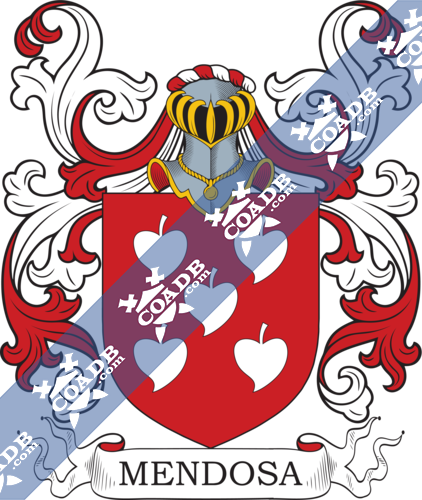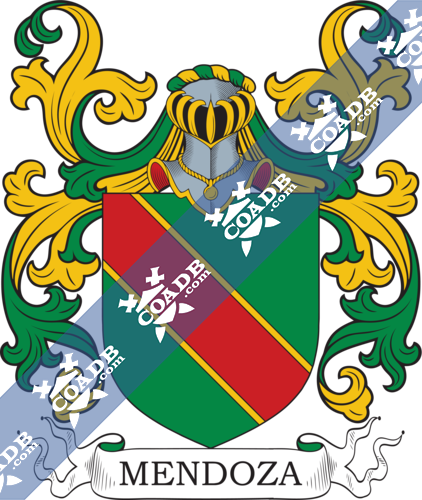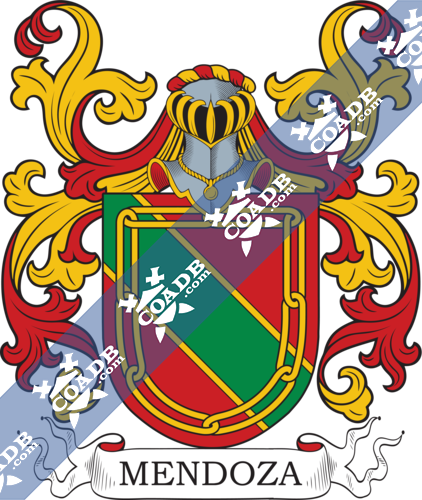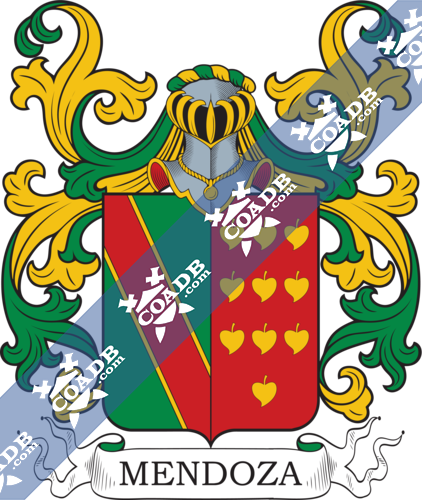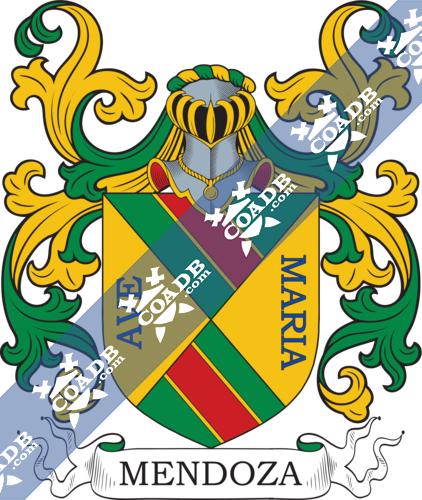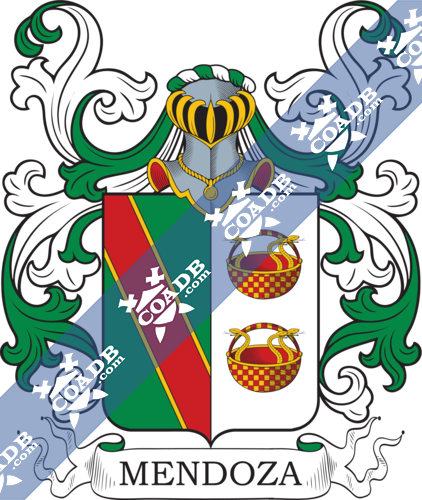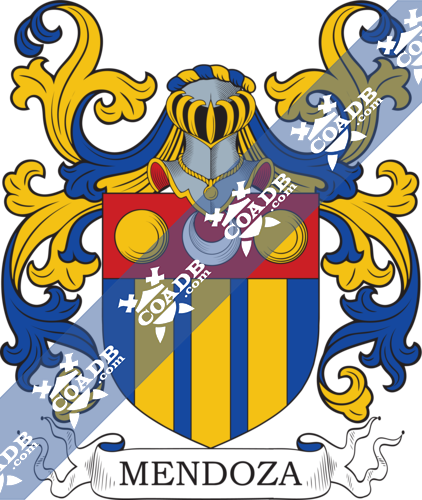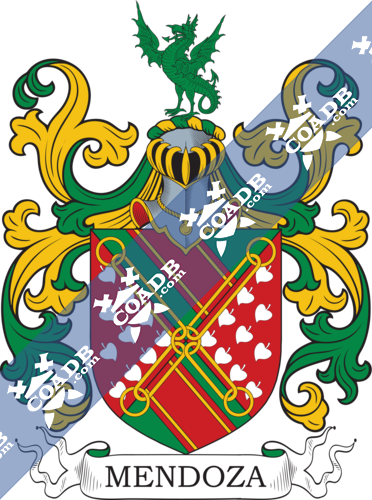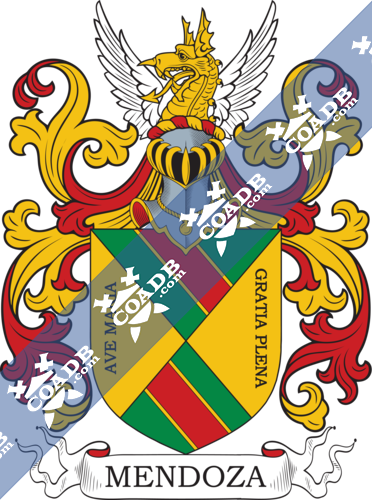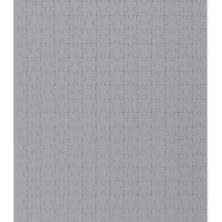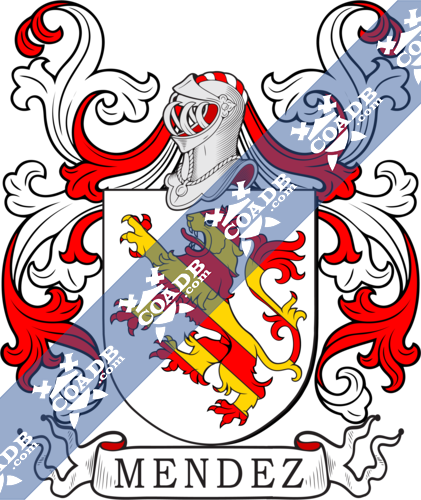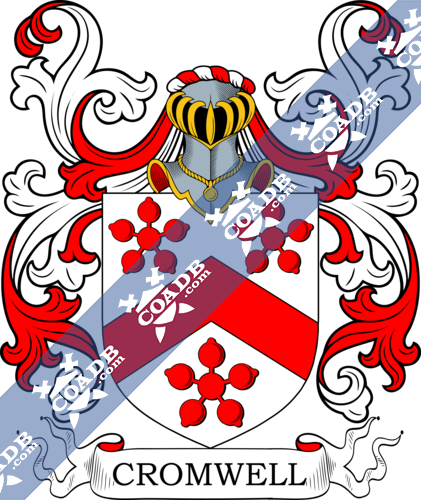Mendoza Family Crest, Coat of Arms and Name History
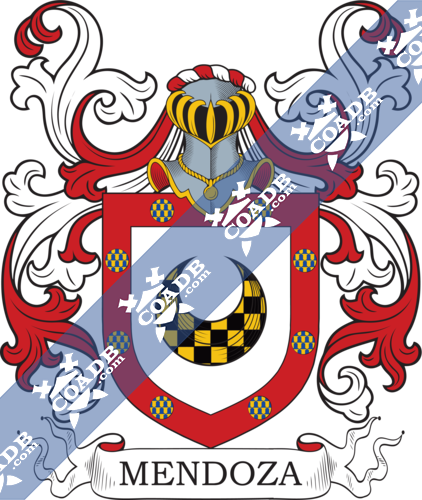
Mendoza Coat of Arms Gallery
Don’t know which Coat of Arms is yours?
We can do a genealogical research. Find out the exact history of your family!
Learn MoreMendoza Surname Name Meaning, Origin, History, & Etymology
According to ancestry.com, this is a last name of Basque origin that was a habitational name referring to persons who lived in or where from places called Mendoza, which were in the provinces of Arava and Biscay, deriving from the Basque word mendi (mountain) and otz (cold) and hence literally translates as cold mountain. Another source says its from the province of Alva.This theory is corroborated by Eldson Coles Smith in his 1956 book “Dictionary of American Family Names” where he asserts this is a Portuguese and/or Spanish surname for a person who came from cold or high mountains, called Mendoza. An alternative theory, proffered by Henry Harrison in his 1912 book “Surnames of the United Kingdom”, from the feminine mendosa of the Spanish word mendoso, meaning mendacious (untruthful/dishonest). It should also be noted that a baserri (a type of farm house) with the same name exists in Erandio, Biscay. It was originally named mendotza, and then evolved to mendontze, and then to mendoche, and then to mendoxte, and finally mendotza.
The name first established itself in the medieval Spanish Kingdom of Castile (1065-1230 AD). The original noble family bearing this surname was based in a castle of the same name, which was located near Vitoria-Gasteiz, Basque Country. However, another branch of this aristocratic family came from Laudio. Futther, the Governors of Granada bore this surname, and were very influential in the establishment of Spain’s Empire in the Americas.
The House of Mendoza was a powerful dynasty of Spanish nobles that wielded authority and influence primarily from the 1300s to the 1600s in Castile. Wikipedia states “In 1332, the Mendozas had already been there at least a century, struggling with the rival clans, such as the Ayala, Orozco, and Velasco. They traced themselves as a stem of the House of Haro, another powerful clan of the Basque countries. Once the Castilian Civil War came to an end with the triumph of Queen Isabella of Castile, the Basque interclan warfare generally ended as well, but even way before, since the 14th century, the Mendoza were jostling for position and privilege in Castile, an expanding military power. By virtue of the Mendozas’ status as knights and free men, they became Castilian nobility with Álava’s annexation (hidalgos)”.
The first of this family to occupy an eminent posirtion in Castile was Gonzálo Yáñez de Mendoza. As part of the Reconquista, the effort to take back the Iberian Peninsula of Europe back Muslim kingdoms of Spain who has been in power for several hundred years, he fought in the Battle of Rio Salado in 1340 AD and also at the Siege of Algeciras several years later. He also was the chief huntsman to King Alfonso XI.
One of the earliest known bearer of this popular European and Latin American last name was Garcia Pedro de Mendoza, who was christened at Jerez de la Frontera in Cadiz Spain in the year 1440 AD. An early baptism in the present day United States was Manuel Mendoza, at the Santa Clara Mission in California in 1785.
Spelling Variations
Some spelling variants or names with similar etymologies include Mendosa, Mendioza, Mendooza, Meendoza, Mendonca, and Menodoza.
Popularity & Geographic Distribution
The last name Mendoza ranks 134th in popularity in the United Status as of the 2000 Census. The name ranks particularly high in the following five states: California, Arizona, Nevada, Texas, and New Mexico.
The surname Mendoza frequency/commonness ranks as follows in other nations around the world: Spain (127th), Portugal (3,470th), Nicaragua (13th), Mexico (21st), Peru (16th), Colombia (60th), Venezuela (17th), Ecuador (33rd), Panama (32nd), Chile (209th), Dominican Republic (128th), Guatemala (55th), Bolivia (19th), Honduras (32nd), Argentina (93rd), El Salvador (44th), Paraguay (58th), Cuba (124th), Philippines (1,139th), Costa Rica (138th), Uruguay (245th), and Brazil (3,696th).
Mendoza Family Tree & Mendoza Genealogy
Here is a lineage or pedigree of this ancient noble family, from father to son:
Íñigo López Ezquerra (born before 1130 AD)
Sancho Íñiguez (born around 1075 AD)
Lope Sánchez, señor de Álava y el Valle de Llodio (born around 1095 AD in Vizcaya, Espana)
Íñigo López de Mendoza Frias, II Señor de Llodio (born around 1115 AD)
Íñigo López de Mendoza, Ier. Señor de Mendoza, III Señor de Llodio (born around 1135)
Gonzalo López de Mendoza, II Señor de Mendoza (born in Spain arouund 1180 AD)
Lope González de Mendoza y García Salvadores, 3er. Señor de Mendoza (born in Vizcaya in 1139 AD)
Diego López de Mendoza, IV señor de Mendoza “Lord of the House of Mendoza” (born around 1195 AD)
Diego Hurtado de Mendoza, señor de Mendivil y Rivera “Lord of Mendivil” (born in Alava, Basque around 1250 AD)
Juan “el Barbudo” Hurtado de Mendoza, VI señor de Mendoza y Mendívil (born around 1265 AD)
Juan “el Viejo” Hurtado de Mendoza, “El Viejo” (born in Alava, Basque Country, Spain in 1305 AD)
Juan ‘el Limpio’ Hurtado de Mendoza, Señor de Almazán y Mendívil (born around 1345 AD in Segovia, Castile and Leon)
Diego Hurtado de Mendoza Téllez de Castilla, primer Marqués de Cañete (born around 1380 in Cuenca, Castilla-La Mancha)
Juan Hurtado de Mendoza Guzmán, 2do. Marqués de Cañete (born between 1395-1445)
Honorato Hurtado de Mendoza y Manrique, Marqués de Cañete (born between in 1425-1485 AD)
Diego Hurtado de Mendoza Silva, I Marqués de Cañete, Virrey de Navarra (born in Barcelona, Spain around 1490 AD)
Andrés Hurtado de Mendoza, II marqués de Cañete y virrey del Perú (born in Granada, Spain in 1510)
Rodrigo Hurtado de Mendoza (born between 1515 and 1567)
Diego Hurtado de Mendoza Pacheco (born in Calahorra, La Rioja, España between 1482-1580)
Jerónimo Hurtado de Mendoza de la Mata (born in Tarazona, Aragona, Espana sometime between 1502-1622)
Diego Hurtado de Mendoza y Cosgalla Antillón Beaumont y Navarra (born in Tarazona, Aragona, Espana sometime between 1559-1619)
Álvaro Hurtado de Mendoza Quiroga, Capitán (born in Santiago, Chile in 1624)
Cristóbal Hurtado de Mendoza y Hernández Pizarro (born in Santiago, Chile in 1660)
Juan Jerónimo Hurtado de Mendoza (born in Santiago around 1708)
Jerónimo Hurtado de Mendoza Salinas (born ???)
Nicolás Hurtado de Mendoza Fuenzalida (born in Rosario, Colchagua, Chile in 1785)
Calixto Antonio Hurtado de Mendoza Gallardo (born in Melipilla, Chile in 1826)
Adolfo Hurtado Olivos (born in 1854)
René Hurtado Borne (born in Santiago, Chile in 1887)
René Luis Adolfo Hurtado Thompson (born in Santiago, Chile in 1917)
Early American and New World Settlers
Some of the earliest documented settlers in the Americas who bore this last name include: Cristobal de Mendoza (1511), Diego de Mendoza (1511), Francisco de Mendoza (Cartagena 1534), Marcos de Mendoza (Peru 1534), and Sancho de Mendoza (Hispaniola 1534).
Mottoes
I have identified two Mendoza family mottoes:
1) Ave Maria (Hail Mary)
2) Gratia Plena (Full of Grace)
Notables
There are hundreds of notable people with the Mendoza surname. This page will mention a handful. Famous people with this last name include: 1) Antonio de Mendoza y Pacheco (1495-1552) who was the first Viceroy of New Spain from 1535-1550 and later the 3rd Viceroy of Pero from 1551-1552, having been born in Alcala la Real in Jaen, Spain, 2) Dayana Sabrina Mendoza Moncada (1986) who is a Venezuela model born in Caracas who won the Miss Universe competition in 2008, 3) Pedro de Mendoza y Luján (1487-1537) who was a Spanish soldier, explorer, conquistador, and the first adelantado (governor) of New Andalusia (one of six colonial governorates in South America), born in Guadix, Granda, 4) Carlos Antonio Mendoza Soto (1956-1916) who was the President of Panama in 1910, 5) José Cristóbal Hurtado de Mendoza y Montilla (1772-1829) who was the first President of Venezula from 1811 to 1812, born in Trujillo, New Granada, 6) Mario Mendoza Aizpuru (1950) who was a Mexican baseball player in the MLB who plated for three teams (Pittsburg Pirates, Seattle Marines, and Texas Rangers) from 1974 to 1982 who was best known for being the source of the name for the threshold for batting ineptitude, “the Mendoza Line”, meaning a batting average of .200, 7) José de Jesús Mendoza Magaña (1979) who was a Mexican football (soccer) player born in Mexico City who played for various teams from 1997 to 2012, and played on the National team for many years as well, 8) de Mendoza y Ríos (1761-1816) who was a Spanish mathematician and astronomer born in Sevilla who was well-known for his work in the field of navigation, and was elected a foreign member of the Royal Swedish Academy of Sciences in 1816, 9) Bernardino de Mendoza (1540-1604) who was a Spanish military commander, diplomat, and writer of history/politics, born in Guadalajara, Spain, son of the third Count of Coruna and Vicecount of Torija, and 10) Mark “The Animal” Mendoza (born in 1956 as Mark Glickman) who was a bassist in rock bands such as Twister Sister and The Dictators, born in West Hempstead, New York.
Blazons & Genealogy Notes
1) Comtes de Mirandola – Castille – D’argent à un croissant échiqueté d’or et de sable à la bordure de gueules ch de huit tourteaux vairés d’or et d’azur. English: Argent with a crescent checky or and sable a bordure gules charged with eight roundels vairy or and azure.
2) Séville – Écartelé en sautoir de sinople et de gueules le sinople ch d’une bande de gueules bordée d’or rebordée de gueules le gueules chargé de dix panelles d’argent les tiges en haut posées dans la direction de l’écartelé 1 2 3 et 4 (à partir du coeur de l’écu) l’une sur l’autre à deux chaînes d’or en sautoir brochant sur l’écartelé réunies en haut et en bas par deux autres chaînes horizontales Cimier un dragon ailé de sinople. English: Quarterly per saltire vert and gules the vert charged with a bend gules fimbriated or and bordured gules the gules charged with ten poplar leaves argent the stems upwards placed in the direction of the quarters 1 2 3 and 4 ( from the heart of the shield ) in pale two chains or saltirewise covering over the quarterly meeting at the top and in base by two other horizontal chains Crest: a wyvern winged vert.
3) Marquis de Cañete – Castille – (Marquis, 1490) – De sinople à la bande de gueules bordée d’or. English: Vert a bend gules fimbriated or.
4) Castille – De gueules à la bande de sinople bordée d’or à une chaîne de huit chaînons d’or posée en orle carrée brochant sur le tout. English: Gules a bend vert fimbriated or with a chain of eight [chain] links or placed in a square orle covering overall.
5) Baeza (Andalousie) – Parti au 1 de sinople à la bande de gueules bordée d’or au 2 de gueules à dix panelles d’or 3 3 3 et 1 les tiges en haut. English: Per pale 1st vert a bend gules fimbriated or 2nd gules with ten poplar leaves or 3 3 3 and 1 the stem upwards.
6) Comtes de Castro-Jeriz – Castille – Écartelé en sautoir de sinople à la bande de gueules bordée d’or ch à dextre des mots AVE MARIA et à senestre des mots GRATIA PLENA côtoyant les flancs Cimier une tête et col de dragon d’or entre un vol à l’antique d’argent Lambrequin d’or et de gueules. English: Quarterly per saltire vert a bend gules fimbriated or charged with to the dexter the words AVE MARIA and to the sinister the words GRATIA PLENA beside the flank Crest: a head and shoulder of wyvern or between a pair of wings with ancient argent Mantling: or and gules.
7) Castille – Écartelé en sautoir aux 1 et 4 de sinople à la bande de gueules bordée d’or aux 2 et 3 d’or ch au 2 du mot AVEd’azur et au 3 du mot MARIA du même côtoyant les flancs. English: Quarterly per saltire 1st and 4th vert a bend gules fimbriated or 2nd and 3rd or charged with 2nd the word AVE azure and 3rd the word MARIA of the same beside the flank.
8) de La Vega – Castille – Parti au 1 les armes de Mendoza marquis de Cañete au 2 d’argent à deux chaudières échiquetées d’or et de gueules l’une sur l’autre et trois têtes de serpent d’or sortant de chaque côté de chaque chaudière les cornières componnées d’or et de gueules. English: Per pale 1st the coat of arms of Mendoza Marquis of Canete 2nd argent two cauldrons checky or and gules in pale and three heads of a snake or coming out of each side of each cauldron the corner irons [where the handles attach?] compony or and gules.
9) Y Manrique – Milan – D’azur à trois pals d’or au chef cousu de gueules chargé d’un croissant d’argent accosté de deux besants d’or). English: Azure three palets or a chief [stitched to the adjacent colour] gules charged with a crescent argent having to the sides two bezants or.
10) None – De gueules à cinq panelles d’argent posées 2 1 et 2. English: Gules with five poplar leaves argent placed 2 1 and 2.

